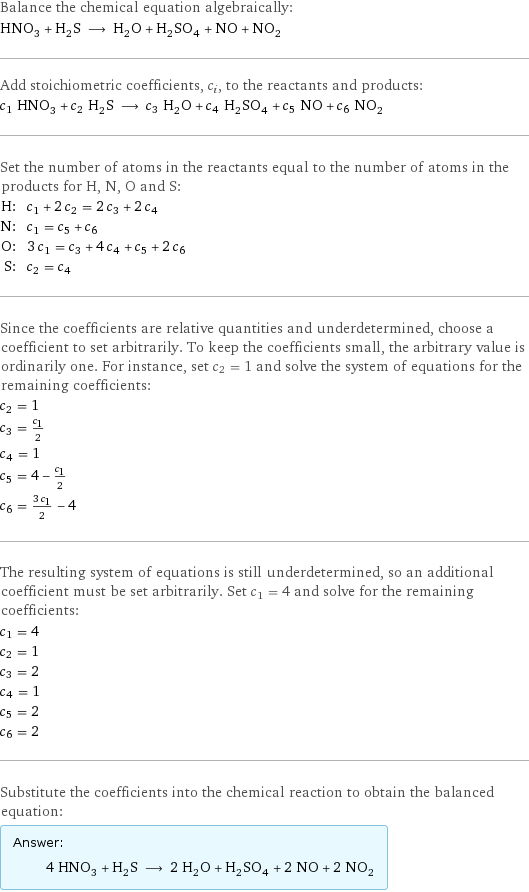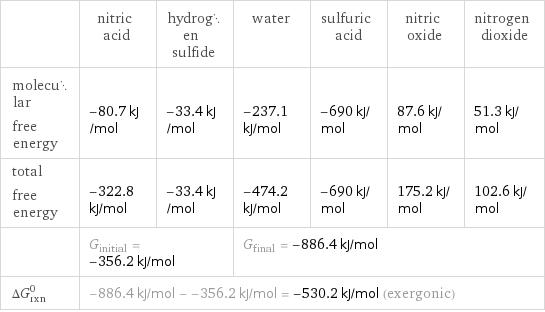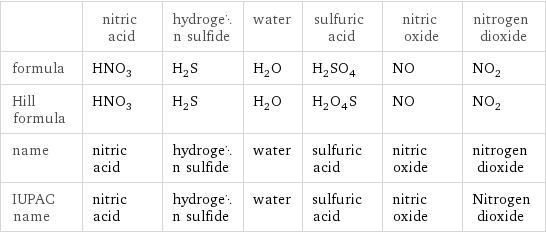Input interpretation

HNO_3 nitric acid + H_2S hydrogen sulfide ⟶ H_2O water + H_2SO_4 sulfuric acid + NO nitric oxide + NO_2 nitrogen dioxide
Balanced equation

Balance the chemical equation algebraically: HNO_3 + H_2S ⟶ H_2O + H_2SO_4 + NO + NO_2 Add stoichiometric coefficients, c_i, to the reactants and products: c_1 HNO_3 + c_2 H_2S ⟶ c_3 H_2O + c_4 H_2SO_4 + c_5 NO + c_6 NO_2 Set the number of atoms in the reactants equal to the number of atoms in the products for H, N, O and S: H: | c_1 + 2 c_2 = 2 c_3 + 2 c_4 N: | c_1 = c_5 + c_6 O: | 3 c_1 = c_3 + 4 c_4 + c_5 + 2 c_6 S: | c_2 = c_4 Since the coefficients are relative quantities and underdetermined, choose a coefficient to set arbitrarily. To keep the coefficients small, the arbitrary value is ordinarily one. For instance, set c_2 = 1 and solve the system of equations for the remaining coefficients: c_2 = 1 c_3 = c_1/2 c_4 = 1 c_5 = 4 - c_1/2 c_6 = (3 c_1)/2 - 4 The resulting system of equations is still underdetermined, so an additional coefficient must be set arbitrarily. Set c_1 = 4 and solve for the remaining coefficients: c_1 = 4 c_2 = 1 c_3 = 2 c_4 = 1 c_5 = 2 c_6 = 2 Substitute the coefficients into the chemical reaction to obtain the balanced equation: Answer: | | 4 HNO_3 + H_2S ⟶ 2 H_2O + H_2SO_4 + 2 NO + 2 NO_2
Structures

+ ⟶ + + +
Names

nitric acid + hydrogen sulfide ⟶ water + sulfuric acid + nitric oxide + nitrogen dioxide
Reaction thermodynamics
Gibbs free energy

| nitric acid | hydrogen sulfide | water | sulfuric acid | nitric oxide | nitrogen dioxide molecular free energy | -80.7 kJ/mol | -33.4 kJ/mol | -237.1 kJ/mol | -690 kJ/mol | 87.6 kJ/mol | 51.3 kJ/mol total free energy | -322.8 kJ/mol | -33.4 kJ/mol | -474.2 kJ/mol | -690 kJ/mol | 175.2 kJ/mol | 102.6 kJ/mol | G_initial = -356.2 kJ/mol | | G_final = -886.4 kJ/mol | | | ΔG_rxn^0 | -886.4 kJ/mol - -356.2 kJ/mol = -530.2 kJ/mol (exergonic) | | | | |
Entropy

| nitric acid | hydrogen sulfide | water | sulfuric acid | nitric oxide | nitrogen dioxide molecular entropy | 156 J/(mol K) | 206 J/(mol K) | 69.91 J/(mol K) | 157 J/(mol K) | 211 J/(mol K) | 240 J/(mol K) total entropy | 624 J/(mol K) | 206 J/(mol K) | 139.8 J/(mol K) | 157 J/(mol K) | 422 J/(mol K) | 480 J/(mol K) | S_initial = 830 J/(mol K) | | S_final = 1199 J/(mol K) | | | ΔS_rxn^0 | 1199 J/(mol K) - 830 J/(mol K) = 368.8 J/(mol K) (endoentropic) | | | | |
Equilibrium constant
![Construct the equilibrium constant, K, expression for: HNO_3 + H_2S ⟶ H_2O + H_2SO_4 + NO + NO_2 Plan: • Balance the chemical equation. • Determine the stoichiometric numbers. • Assemble the activity expression for each chemical species. • Use the activity expressions to build the equilibrium constant expression. Write the balanced chemical equation: 4 HNO_3 + H_2S ⟶ 2 H_2O + H_2SO_4 + 2 NO + 2 NO_2 Assign stoichiometric numbers, ν_i, using the stoichiometric coefficients, c_i, from the balanced chemical equation in the following manner: ν_i = -c_i for reactants and ν_i = c_i for products: chemical species | c_i | ν_i HNO_3 | 4 | -4 H_2S | 1 | -1 H_2O | 2 | 2 H_2SO_4 | 1 | 1 NO | 2 | 2 NO_2 | 2 | 2 Assemble the activity expressions accounting for the state of matter and ν_i: chemical species | c_i | ν_i | activity expression HNO_3 | 4 | -4 | ([HNO3])^(-4) H_2S | 1 | -1 | ([H2S])^(-1) H_2O | 2 | 2 | ([H2O])^2 H_2SO_4 | 1 | 1 | [H2SO4] NO | 2 | 2 | ([NO])^2 NO_2 | 2 | 2 | ([NO2])^2 The equilibrium constant symbol in the concentration basis is: K_c Mulitply the activity expressions to arrive at the K_c expression: Answer: | | K_c = ([HNO3])^(-4) ([H2S])^(-1) ([H2O])^2 [H2SO4] ([NO])^2 ([NO2])^2 = (([H2O])^2 [H2SO4] ([NO])^2 ([NO2])^2)/(([HNO3])^4 [H2S])](../image_source/ce43dcd9a0913bfb9bc1e4e1913d91ad.png)
Construct the equilibrium constant, K, expression for: HNO_3 + H_2S ⟶ H_2O + H_2SO_4 + NO + NO_2 Plan: • Balance the chemical equation. • Determine the stoichiometric numbers. • Assemble the activity expression for each chemical species. • Use the activity expressions to build the equilibrium constant expression. Write the balanced chemical equation: 4 HNO_3 + H_2S ⟶ 2 H_2O + H_2SO_4 + 2 NO + 2 NO_2 Assign stoichiometric numbers, ν_i, using the stoichiometric coefficients, c_i, from the balanced chemical equation in the following manner: ν_i = -c_i for reactants and ν_i = c_i for products: chemical species | c_i | ν_i HNO_3 | 4 | -4 H_2S | 1 | -1 H_2O | 2 | 2 H_2SO_4 | 1 | 1 NO | 2 | 2 NO_2 | 2 | 2 Assemble the activity expressions accounting for the state of matter and ν_i: chemical species | c_i | ν_i | activity expression HNO_3 | 4 | -4 | ([HNO3])^(-4) H_2S | 1 | -1 | ([H2S])^(-1) H_2O | 2 | 2 | ([H2O])^2 H_2SO_4 | 1 | 1 | [H2SO4] NO | 2 | 2 | ([NO])^2 NO_2 | 2 | 2 | ([NO2])^2 The equilibrium constant symbol in the concentration basis is: K_c Mulitply the activity expressions to arrive at the K_c expression: Answer: | | K_c = ([HNO3])^(-4) ([H2S])^(-1) ([H2O])^2 [H2SO4] ([NO])^2 ([NO2])^2 = (([H2O])^2 [H2SO4] ([NO])^2 ([NO2])^2)/(([HNO3])^4 [H2S])
Rate of reaction
![Construct the rate of reaction expression for: HNO_3 + H_2S ⟶ H_2O + H_2SO_4 + NO + NO_2 Plan: • Balance the chemical equation. • Determine the stoichiometric numbers. • Assemble the rate term for each chemical species. • Write the rate of reaction expression. Write the balanced chemical equation: 4 HNO_3 + H_2S ⟶ 2 H_2O + H_2SO_4 + 2 NO + 2 NO_2 Assign stoichiometric numbers, ν_i, using the stoichiometric coefficients, c_i, from the balanced chemical equation in the following manner: ν_i = -c_i for reactants and ν_i = c_i for products: chemical species | c_i | ν_i HNO_3 | 4 | -4 H_2S | 1 | -1 H_2O | 2 | 2 H_2SO_4 | 1 | 1 NO | 2 | 2 NO_2 | 2 | 2 The rate term for each chemical species, B_i, is 1/ν_i(Δ[B_i])/(Δt) where [B_i] is the amount concentration and t is time: chemical species | c_i | ν_i | rate term HNO_3 | 4 | -4 | -1/4 (Δ[HNO3])/(Δt) H_2S | 1 | -1 | -(Δ[H2S])/(Δt) H_2O | 2 | 2 | 1/2 (Δ[H2O])/(Δt) H_2SO_4 | 1 | 1 | (Δ[H2SO4])/(Δt) NO | 2 | 2 | 1/2 (Δ[NO])/(Δt) NO_2 | 2 | 2 | 1/2 (Δ[NO2])/(Δt) (for infinitesimal rate of change, replace Δ with d) Set the rate terms equal to each other to arrive at the rate expression: Answer: | | rate = -1/4 (Δ[HNO3])/(Δt) = -(Δ[H2S])/(Δt) = 1/2 (Δ[H2O])/(Δt) = (Δ[H2SO4])/(Δt) = 1/2 (Δ[NO])/(Δt) = 1/2 (Δ[NO2])/(Δt) (assuming constant volume and no accumulation of intermediates or side products)](../image_source/91449d48ba4dc3e802eb4a7fba9381c9.png)
Construct the rate of reaction expression for: HNO_3 + H_2S ⟶ H_2O + H_2SO_4 + NO + NO_2 Plan: • Balance the chemical equation. • Determine the stoichiometric numbers. • Assemble the rate term for each chemical species. • Write the rate of reaction expression. Write the balanced chemical equation: 4 HNO_3 + H_2S ⟶ 2 H_2O + H_2SO_4 + 2 NO + 2 NO_2 Assign stoichiometric numbers, ν_i, using the stoichiometric coefficients, c_i, from the balanced chemical equation in the following manner: ν_i = -c_i for reactants and ν_i = c_i for products: chemical species | c_i | ν_i HNO_3 | 4 | -4 H_2S | 1 | -1 H_2O | 2 | 2 H_2SO_4 | 1 | 1 NO | 2 | 2 NO_2 | 2 | 2 The rate term for each chemical species, B_i, is 1/ν_i(Δ[B_i])/(Δt) where [B_i] is the amount concentration and t is time: chemical species | c_i | ν_i | rate term HNO_3 | 4 | -4 | -1/4 (Δ[HNO3])/(Δt) H_2S | 1 | -1 | -(Δ[H2S])/(Δt) H_2O | 2 | 2 | 1/2 (Δ[H2O])/(Δt) H_2SO_4 | 1 | 1 | (Δ[H2SO4])/(Δt) NO | 2 | 2 | 1/2 (Δ[NO])/(Δt) NO_2 | 2 | 2 | 1/2 (Δ[NO2])/(Δt) (for infinitesimal rate of change, replace Δ with d) Set the rate terms equal to each other to arrive at the rate expression: Answer: | | rate = -1/4 (Δ[HNO3])/(Δt) = -(Δ[H2S])/(Δt) = 1/2 (Δ[H2O])/(Δt) = (Δ[H2SO4])/(Δt) = 1/2 (Δ[NO])/(Δt) = 1/2 (Δ[NO2])/(Δt) (assuming constant volume and no accumulation of intermediates or side products)
Chemical names and formulas

| nitric acid | hydrogen sulfide | water | sulfuric acid | nitric oxide | nitrogen dioxide formula | HNO_3 | H_2S | H_2O | H_2SO_4 | NO | NO_2 Hill formula | HNO_3 | H_2S | H_2O | H_2O_4S | NO | NO_2 name | nitric acid | hydrogen sulfide | water | sulfuric acid | nitric oxide | nitrogen dioxide IUPAC name | nitric acid | hydrogen sulfide | water | sulfuric acid | nitric oxide | Nitrogen dioxide